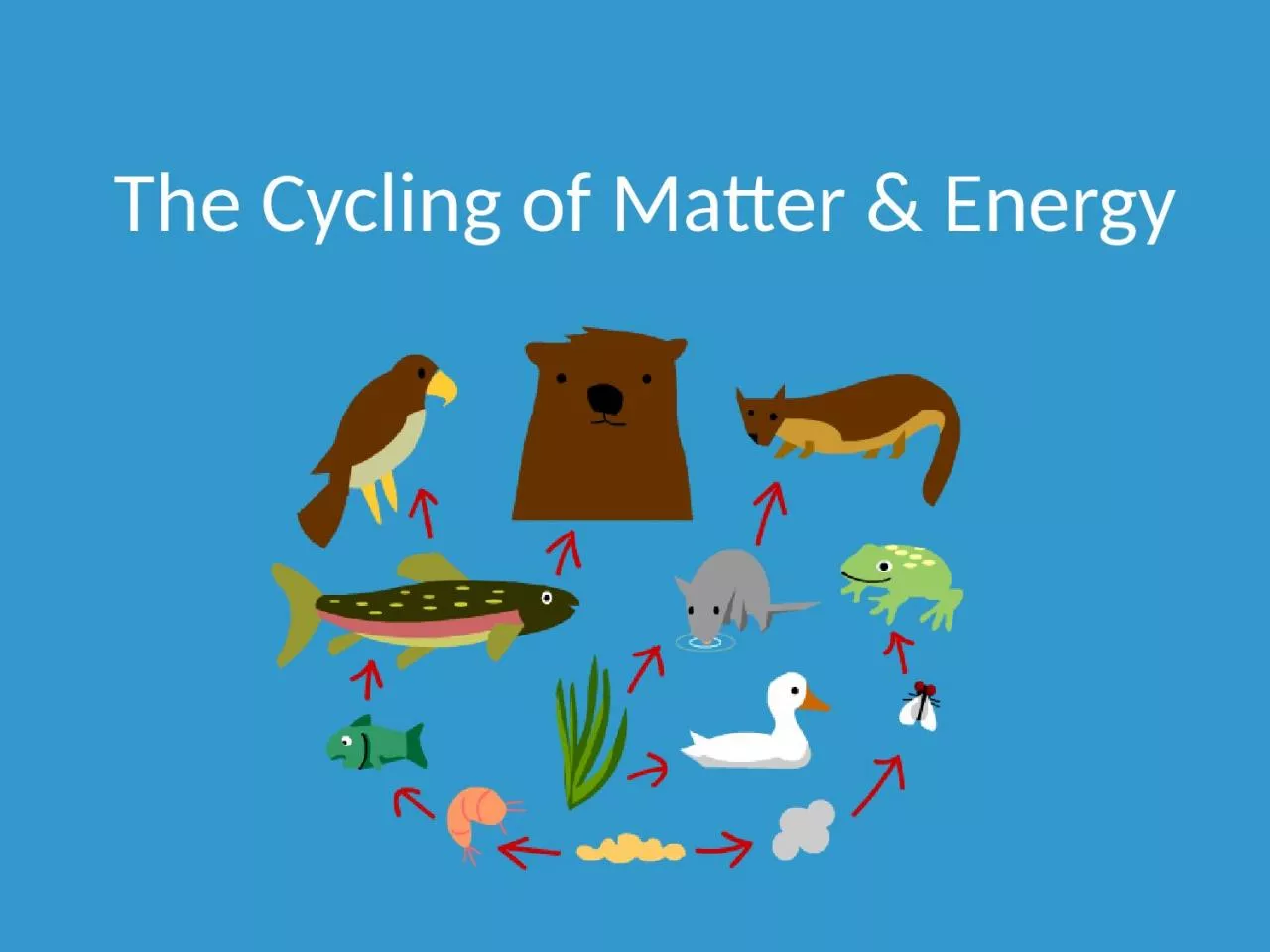

Lets Start with the Big Picture Biome Biomes Shown here are arctic tundra savannah and mountain biomes A geographical region that has characteristic climate plant and animal life There can be many ecosystems ID: 1026115
Download Presentation The PPT/PDF document "The Cycling of Matter & Energy" is the property of its rightful owner. Permission is granted to download and print the materials on this web site for personal, non-commercial use only, and to display it on your personal computer provided you do not modify the materials and that you retain all copyright notices contained in the materials. By downloading content from our website, you accept the terms of this agreement.
1. The Cycling of Matter & Energy
2. Let’s Start with the Big Picture:BiomeBiomesShown here are arctic tundra, savannah, and mountain biomesA geographical region that has characteristic climate, plant, and animal lifeThere can be many ecosystems within a biome!
3. Community of interacting organisms within a biome living in BalanceEcosystemsEach organism plays a role in their ecosystem to maintain balance
4. OrganismsIndividual living things AnimalsPlants EubacteriaArchaeProtistsFungi All organisms live in balance in ecosystemsFood web within an ecosystem
5. Living organisms in ecosystems are called biotic componentsGrouped as:ProducersConsumersDecomposersMake their own foodEat other organisms for foodBreak down dead material AutotrophsHeterotrophsDetritivores
6. Producers make their own food throughby converting sunlight energy into carbohydrates which give energy to consumersPhotosynthesis Producers
7. There are three types of consumers: Primary Consumers Herbivore-eats only plants (producers)Secondary Consumers-carnivore thateats primary consumers or omnivore that eats a combination of primary consumers and producersTertiary Consumers eats only secondary consumers-the topmost carnivore in an ecosystem
8. Classify these CrittersSquirrelsLionsRabbitsFoxesCoyotesTreesSheepZebrasDeerGreen AlgaePrimary ConsumersProducersSecondary ConsumersBobcatsGophersInsectsCowsOwlsGrassTigersPigsFlowersMiceCyanobacteria*Humans*Tertiary ConsumersAre they all easy? Do some fit in multiple categories?
9. Energy Flow in EcosystemsPrimary Consumers eat Producers for nutrients and energy Solar Energy from the SunProducers photosynthesize to make carbohydratesSecondary Consumers eat Primary Consumers for nutrients and energyDecomposers recycle dead organic waste (biomass)Energy TransferStart!Tertiary Consumers eat Secondary Consumers for nutrients and energy
10. Energy Cycling
11. Energy Flow within an EcosystemSunProducersPrimary ConsumerSecondary/TertiaryConsumerDecomposersHeatHeatHeatHeatChemical EnergyChemical EnergySolar EnergyOrganic WasteOrganic WasteOrganic WasteHeat
12. Decomposition/DecayDecomposers are usually put at the bottom of a food web, but they are very important because they cycle biomass.Decomposersconsume dead plants & animals (biomass) to recycle them back to nutrients for producers
13. BiomassBiomass is organic matter left behind when organisms die or as a byproduct of some industries.Decomposers cycle biomass back into the food web by converting this organic matter into carbon dioxide and nutrients.Energy is released in the form of heat during this process.Biomass is also considered a renewable energy source!
14. Nutrients that decomposers recycle back into the soil:WaterCarbonNitrogenPhosphorusThese are essential to all life but are only present in finite amounts throughout the world hence the need for cycling of nutrients in ecosystems
15. Decomposers: Bacteria-Unicellular organisms-Can break down just about any type of organic matter-Live on land, air and sea-1 gram of soil (about a paperclip’s weight) contains 40 million (40,000,000)bacterial cells!
16. Decomposers: Fungi-Are not plants-Does include molds-Fungi release enzymes to decompose decaying material -Fungi grow on hyphae:unseen strands beneath the surface of the material they are decomposing
17. Fungi in action!Mold growth over a decaying peach Life of Fungi&
18. EarthwormsEarthworms act as scavengersEarthworms breathe through their skin They do not have eyes but do have light & touch sensitive organsEarthworms are hermaphroditic which means they have both male and female organsDecomposers:
19. CompostingControlled Decomposition – in your backyard! HumusMature compost ready to deliver the nutrients from decomposed materials back to producers.
20. Composting requires a mixture of – 1. Browns – carbon source2. Greens – nitrogen source 3. Water leaves, branchesgrass,food scraps4. Air
21. Worms are nature’s ultimate recyclers!Worm composing or vermiculture is just like composting, only red worms do the decomposing. Red worms can eat their weight in organic matter every day.They leave behind casings or casts that are rich in nutrients.worms
22. Why Compost?Think of different reasons that the composting cycle is important to YOU!
23. Why Compost?Turn dead organic waste (biomass), like dead leaves and table scraps, into a healthy, natural fertilizer for your gardens and lawns. The humus can replenish nutrients in the soil. Results:Higher crop yieldsEnrich soilCleaner soil & airSuppress plant diseasesReduce waste without a landfill!
24. The Big Picture:Cycling of Nutrients